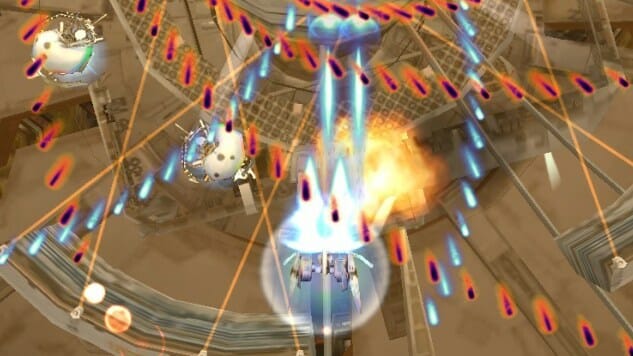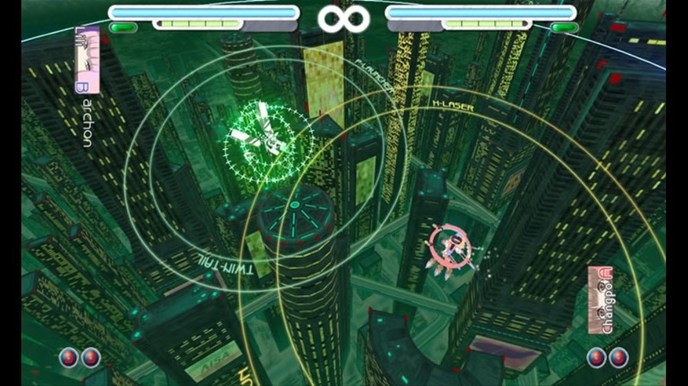
When you hear “bullet hell” what do you think of? It’s not a new term, but it’s gained increasing prominence in the mainstream games discussion over the last decade, and is often associated with any game with overwhelming numbers of enemy projectiles. While these barrages of bullets are what immediately capture attention, the genre is better defined by the way that it forces players to react to space. Taking elements from it can create new, novel approaches to the way we play in already established genres. Like roguelikes, the bullet hell genre has also seen a small number of games do just that, growing a small niche into something more visible and influential. It’s also muddied definitions of what exactly the genre is, and the elements that make it unique.
In the strictest sense, “bullet hell” is a sub-genre of scrolling shooters, often but not strictly vertically oriented, that focus on intricate patterns of enemy projectiles, often building to encounters where most of the available play space is blanketed in bullets. To make this feasible, the player is usually provided a tiny hitbox, highly visible bullets and mechanics useful for managing enemy fire. This can be a bomb that clears the entire screen of bullets, absorption abilities or attacks that can cancel certain types of bullets to create openings. Attacks that aim directly are also generally limited, since they can create situations in which the player can’t avoid being hit.
In a way, bullet hell is about seeing what’s not there. The aim isn’t dodging individual bullets, but recognizing the patterns and navigating through openings in them.
The focus on spatial and pattern recognition makes it a natural fit for other action games. The obvious first candidates are other shooters, particularly twin-stick arena shooters. While it might seem to be a simple transplant, twin-stick shooters employ a more confined playing field, compared to the wide and narrow spaces of scrolling shooters. The corridor-like space of bullet hell games means that attacks often only move in one direction—if an enemy or bullet is behind you, generally you’re safe from it. Twin-stick shooters, by contrast, rely on attacks that surround a player from all sides.
Combining those multi-directional attacks with the overwhelming firepower of bullet hell might initially seem like a recipe for frustration, but smart games can use the more open spaces to their advantage. Witch Beam’s Assault Android Cactus, for instance, uses a dynamically changing environment to alter the play space and force you to hold certain areas.
Talking to Sanatana Mishra from Witch Beam, he specifically cited games by the developer Treasure, such as Radiant Silvergun, Gunstar Heroes and Ikaruga as inspiration for the way they used bullet hell elements. “Treasure never really went all in on concepts like bullet hell in their games, but they always found a way to use those elements to enhance their own ideas,” Mishra told me over email. “I think you can see that in Cactus where we mix the freedom of movement and aiming that twin sticks provide with a sort of organic bullet hell created by our enemies using complex attacks.”
Witch Beam also made efforts to mitigate chaos in order to make sure the screen was readable at a glance. What’s interesting is that sometimes this means using more bullets, not less. “We realized early on that people are incredible pattern recognition machines but not so great at reacting quickly to chaotic threats, so we designed all our enemies to use large but easily identifiable threat patterns since it’s easier to dodge 100 bullets that all appear connected in some way than dodge 30 bullets that appear to be moving independently.”
Of course, bringing those patterns to a new genre also requires some tweaking. In a feature on Rock, Paper, Shotgun, Dave Crooks, lead designer on Enter the Gungeon, a twin-stick roguelike, explained that integrating these patterns required more than transplanting the intricate patterns of the genre:
“They (the bullets) don’t just have to know where they are and should be going, they need to know where the player is in the room, where the other bullets are, and to be able to have complex movement that’s not just based on speed and acceleration, but also game rules.”
Because of these “smart bullets” Enter the Gungeon was also free to aim more attacks directly at the player, since there’s a larger area to move around within, and attacks avoid combining in overwhelming ways. Most importantly, Gungeon focuses more on expressive bullet patterns than pixel perfect movement. Key to this is the dodge roll, which gives you a short window of invincibility, letting you dodge through bullets and into open spaces. So attacks can still come from all angles, but you’ll never have to be in a single particular space to avoid damage.
Combining fast movement with bullet hell can also be empowering. That’s crucial to the dynamic of Furi, a one-on-one arena fighter. “I wanted to have a bullet hell element in Furi because I thought that would add depth and variety to a classic swordfight beat’em up game. It adds ranged gameplay and focuses on movement,” designer Emeric Thoa told me. This manifests in Furi through several phases of each boss, forcing you to move between short and long range combat to exploit openings in boss patterns. These often involve large area of effect attacks, not unlike something you’d see when fighting an MMO boss. The difference is that Instead of marking an area with a danger indicator, Furi fills it with bullet patterns.
Getting these attacks to work with a mobile character introduces some complications, though. “One of the challenges we faced was that at first we designed huge arenas, but with a very fast character like ours, it was too easy to avoid the bullets.” This required Thoa and his team to create restrictions to keep players from avoiding these danger zones entirely. “We ended up working a lot on the arena designs, restraining it dynamically in some levels.” The result ends up with something similar to Assault Android Cactus, where boss phases trigger a change in stage layout to suit their next pattern of attacks. Taken with other examples, it shows how the bullet hell experience can be dramatically altered by the play space.
Movement can be used to mix up bullet hell in others ways, of course. One of the more esoteric examples of this is Senko no Ronde, a mecha fighting game/bullet hell hybrid. It was created by G. Rev, shooter veterans who had a major part in creating the polarity switching shooter, Ikaruga. Like Furi it takes a one-on-one arena format, and focuses on movement. But Senko no Ronde works more in the fighting game mold, rather than the hack and slash style of Furi. Players uses various bullet based attacks to deplete each other’s heath. This turns the focus away from pattern recognition towards reading your opponents, and controlling space yourself to prevent them from closing in. Key to this are two elements: dashing mechanics borrowed from games like Virtual-On or Dissidia Final Fantasy, and a reversal of genre conventions that makes you the one firing the bullet patterns.
In Senko no Ronde dashing moves you quickly in one direction, but requires a brief delay before you can perform another move. This allows you to quickly escape bullets, but also creates an opening that can be taken advantage of after. Likewise, attacks have to be used carefully, as they create their own openings and can be spent if used too often. This forces players to carefully consider their moves, and attacks often become not about hitting each other directly, but reading the enemy and forcing them into a space where they can’t avoid being hit. To do this you’ll fire bullet hell patterns at each other, with each character having their own set of moves and modifiers to create tricky situations for others. Patterns get even more hectic when a player uses their B.O.S.S. move, which makes them into a full on bullet hell boss.
Senko no Ronde is one of the more niche genre hybrids here, but there’s plenty of other unique combinations. Take Harmonix’s City That Sleeps, a shooter/rhythm hybrid where bullets and enemies interact with the rhythm of the current backing track. On the other side of the spectrum are RPG hybrids like Knights in the Nightmare, Undertale and even Nier: Automata. Nier: Automata is the most conventional of the three, building on the approaches of other action games. It contains plenty of the RPG conventions of the genre, but mixes hack and slash style combat with bullet hell combat, sometimes even pulling out into a top down or sidescrolling perspective, and operating more like a twin stick shooter, demanding you aim gunfire from a helper robot to cancel bullets and fend off foes.
Knights in the Nightmare and Undertale, meanwhile, each operate in different flavors of RPG, Knights being a tactics game, and Undertale following the format of the Earthbound series, but each of them use bullet hell patterns to create active combat systems and characterize enemies. Battles in Knights require you to navigate a “Wisp” through a hail of fire while interacting with soldiers to give them commands. Each enemy will also fire out bullets that fit their character. Slimes might fire out large, slow moving blobs, while magicians can create magic circles that surround you and shatter into dangerous fragments.
Undertale uses bullet patterns similarly, though it often adds a touch of humor and makes battles feel more like minigames. Battles occur within a small window, with your character being represented by a heart icon. While there are plenty of moments of hectic bullet dodging, you might also have to dodge a frog’s attack by avoiding a leaping frog icon, or avoid a body builder’s flexing arms rushing towards you. A large part of battle is adapting to each minigame, learning how each character fights as you do. It makes each character memorable, with the hope that by making each character pattern unique, it can make you rethink the RPG trope of random battles and consider those characters as more than enemies.
Smart use of bullet hell mechanics can have a similar effect for other genre tropes. Aside from adding novelty, bullet hell conventions can change drastically depending on the space it’s played in. This in turn changes the relationship of the player to the spaces they play around in. Given proper consideration of each genre’s strengths, it can bring the appeal of multiple genres to a new audience. Those intimidating whirlwinds of bullets might be the most iconic part of the genre, but hidden in them is a playful new way to experiment with established ideas.
Amr Al-Aaser is an Egyptian-Filipino American writer and artist operating out of Chicago. They also co-edit Deorbital and Clickbliss. You can find them rambling about robots on Twitter @siegarettes.

